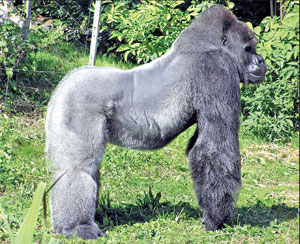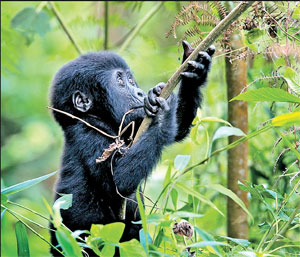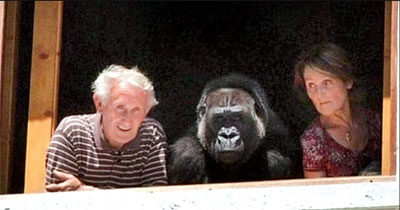Gorillas –The gentle apes of Africa
 Gorillas, the very mention of their name may send a shiver down your
spines because these large, blackish- brown furry creatures are often
portrayed as aggressive and dangerous killers. However, they are not so.
Many researchers call them the gentle apes of Africa.Would you believe
that they are actually shy, peaceful vegetarians? Perhaps not, going by
their appearance. What is most interesting is their level of
intelligence.It is said that they are very intelligent and can learn
extremely complex tasks.Some gorillas have even been taught sign
language by people; these gorillas learned how to form simple sentences
and communicate with people.The story of Digit the gorilla featured here
will enlighten you as to how intelligent and gentle these creatures,
which are the next closest living relatives to humans, after the bonobo
and chimpanzee can be.... Gorillas, the very mention of their name may send a shiver down your
spines because these large, blackish- brown furry creatures are often
portrayed as aggressive and dangerous killers. However, they are not so.
Many researchers call them the gentle apes of Africa.Would you believe
that they are actually shy, peaceful vegetarians? Perhaps not, going by
their appearance. What is most interesting is their level of
intelligence.It is said that they are very intelligent and can learn
extremely complex tasks.Some gorillas have even been taught sign
language by people; these gorillas learned how to form simple sentences
and communicate with people.The story of Digit the gorilla featured here
will enlighten you as to how intelligent and gentle these creatures,
which are the next closest living relatives to humans, after the bonobo
and chimpanzee can be....

Let’s check out some interesting facts about these majestic primates
which are fast becoming extinct due to massive habitat loss and
poaching. Leopards and humans are their only known enemies. Scientists
estimate that there are roughly 50,000 gorillas left in the wild in
Africa. Most of these are western lowland gorillas; there are only about
600 mountain gorillas and 2,500 eastern lowland gorillas. Mountain
gorillas are on the verge of extinction. Gorillas are covered with
brownish hair(which looks more like black) on most of their body except
their fingers, palms, face, armpits, and bottoms of their feet. They
have very long arms (the arms are longer than the legs), and a short,
bulky body with a wide chest.Their large heads with a bulging forehead
has a crest on top and it is called the sagittal crest.Their ears are
comparatively tiny and eyes too are small and dark-brown in colour.They
have no tails. Did you know that each gorilla has a unique nose print
just like we have unique fingerprints?
An adult male gorilla which is known as a silverback is twice as much
heavier than the females. Silverbacks, range in height 1.65 -1.75 metres
(5 ft 5 in - 5 ft 9 in), and in weight 140 - 200 kg (310 - 440 lb).
Adult females are often half the size of a silverback, averaging about
1.4 metres (4 ft 7 in) tall and 100 kg (220 lb). Occasionally, a
silverback of over 1.8 metres (5 ft 11 in) and 230 kg (510 lb) has been
recorded in the wild. Obese gorillas in captivity have reached a weight
of 270 kg (600 lb)The silverback is the centre of the troop’s attention,
making all the decisions, mediating conflicts, determining the movements
of the group, leading the others to feeding sites and taking
responsibility for the safety and well-being of the troop. Younger males
subordinate to the silverback, known as blackbacks, may serve as backup
protection.The bond a silverback has with his females forms the core of
gorilla social life. Gorillas’ senses are sharp and very similar to
ours, including hearing, sight smell, taste, and touch.

A silverback |

A gorilla family at the Miami Zoo |
|

A baby gorilla learning skills |
They seem to be slightly nearsighted and are known to have colour
vision too. You may have noticed in photographs that they have hands
that are very similar to ours; five fingers, including an opposable
thumb. Even their feet have five toes, including an opposable big toe.
And so they can grasp things with both their hands and their feet.
Gorillas are able to reproduce at 10-12 years old. After a
gestation(pregnancy period) of about 8 to 9.5 months, the female
gorillas produce a baby which weighs about 3-4 pounds (1.4 to 1.8 kg),
about half the weight of a newborn human. The females give birth to
about three babies in their lifetime. The young are carefully nurtured
by their mothers. The baby gorillas learn to crawl at about two months
and can walk before they are nine months old,which is much earlier than
humans. By the time they are four months old they can go on a piggy back
ride on their mother’s back because they are able to grasp their
mother’s fur.
Like human babies, baby gorillas too are fed mother’s milk for the
first 2 1/2 years of life. Once they are weaned,the baby gorillas do not
snuggle with their mothers in the same nest. They sleep on their own so
they begin to build their own sleeping nests out of vegetation. They no
longer use their mother’s nest!Each evening, gorillas construct a “nest”
for the night in which they will curl up and sleep. These bowl-shaped
nests are made out of leaves and other plant material. Nests are only
shared by a mother and her nursing offspring. Gorillas construct nests
for daytime and night use. Day nests tend to be simple aggregations of
branches and leaves on the ground while night nests are more elaborate
constructions in trees. The nests may be 2 to 5 feet (0.61 to 1.5 m) in
diameter and are constructed by individuals. The young gorillas stay
with their mother for only about 3-4 years. Adult male gorillas
(silverbacks) will care for weaned orphaned young gorillas.
|

Ambam at Port
Lympne wild animal
park, Kent has
mastered the art of
walking like
humans. |
Predominantly herbivores they mostly eat plant material; leaves,
fruit, seeds, tree bark, plant bulbs, tender plant shoots, and flowers.
They have been known to eat various parts of over 200 different plant
species. Occasionally, gorillas supplement their diet with termites and
ants. They forage for food in the forests during the day. They do not
drink much water because they apparently get enough to sustain them from
their diet .Gorillas are shy, social animals that live in small groups
(or bands) of 6-7 individuals, including one silverback (adult male), a
few females, and their young. When the young mature, they go off and
join or form another band.They are active during the day (diurnal).
Grooming one another (cleaning the hair of another gorilla) is a
major occupation among gorillas in a band. Female gorillas groom their
offspring, one another, and the silverback but the silverback does not
groom others. Gorillas are not aggressive animals. When an intruder
disturbs them, they may make a lot of noise, but they rarely confront
another animal.They are generally quiet animals and communicate with
each other using many complicated sounds and gestures.
The ups and downs of living with a gorilla
The Thivillons have been caring for Digit the gorilla for more than a
decade, but having a primate at home throws up some unlikely problems.
In a village near Lyon
 in south-east France, the couple have become
local celebrities by virtue of their adopted “child”.Digit, as she is
known, has been living in the same room as Pierre and Elaine Thivillon
for nearly 13 years. in south-east France, the couple have become
local celebrities by virtue of their adopted “child”.Digit, as she is
known, has been living in the same room as Pierre and Elaine Thivillon
for nearly 13 years.
Their relationship began in 1999, when the young primate came into
the care of the couple, who manage the zoo at Saint Martin la Plaine
where she was born.Within three days of her birth, it was clear that
Digit’s mother Pamela was refusing to feed her.
The Thivillons took her into their care, bottle-feeding her during
the day and returning her to her enclosure at night.
By 18 months old, the baby gorilla had begun to show a deep
attachment to her foster parents. After an illness left her requiring
24-hour care, Pierre and Elaine took her into their bedroom at night,
where she has slept ever since.
For the first 10 years, she snuggled up between the couple, but now
at 130kg (287lbs) she has to have a bed of her own.
Although she has free reign of the couple’s small apartment, during
the day she rambles around her enclosure which is next door.
“I don’t go in there as it’s Digit’s home,” says Elaine,
acknowledging the young teenager’s right to privacy. “Only Pierre is
allowed in there.” Having a gorilla in the family is not without its
problems.

“This morning I brought four raisin buns for our breakfast,” says
Pierre. “When I had my back turned she managed to finish four of them
before I could save one. Then she turned her attention to Elaine’s
coffee.”
“She loves chocolate,” says Elaine, and sometimes she will drink an
entire cup of coffee in search of the little sweet Elaine dunks in
there.
The couple, who have no children, are often asked if they consider
Digit as their daughter. “I wouldn’t say we see her as our child as
such, but she is someone who is very dear to me,” explains Elaine. “She
is part of our family and I do treat her as a mother would. Sometimes I
will say: ‘No, no more sweets Digit’, and then she will give me three or
four kisses and I give in.”The trio have learned to transcend the
barriers of language to communicate with each other.
“We recognise the noises that she makes. This morning she made a
little grunt to show me that she was happy,” says Elaine. “She
understands what we tell her too.”
“The other day she was sitting on the sofa and I said, ‘Come on
Digit, give me some space,’ and she moved over.
“In the morning, when she wants her toys or her Lego or her books,
she just points to the cupboard where they are kept.”
Encouraging a teenager to read is a challenge for any parent, but
what kind of books is a 13-year-old gorilla interested in?
“She has animal books and catalogues,” Elaine explains. “Sometimes
she looks through them and she’ll stop on a page and I’ll explain to
her, this is a cat or this is another animal.”
When playing with her Lego she is limited to the big chunks as the
little ones slip through her enormous fingers.Every evening when Pierre
has finished his rounds at the zoo, he and his wife have a quick meal
before they retire to their bedroom.
 “I stay and play with Digit until she makes signs that she wants to
go to sleep,” says Pierre. “Then we prepare a pillow for her, we cover
her up and she makes happy little grunting sounds. Then we just watch
her until she falls asleep.” “I stay and play with Digit until she makes signs that she wants to
go to sleep,” says Pierre. “Then we prepare a pillow for her, we cover
her up and she makes happy little grunting sounds. Then we just watch
her until she falls asleep.”
Her brother Ginko joined them too for a while but when he grew too
big he moved out into one of the enclosures. Digit remains, never more
than a metre away from the couple.”In the night, if she is thirsty she
will find my hand and give it a little tug, sometimes she will tug at my
feet,” says Pierre.
“We try to be attentive to her needs - not that she is spoilt rotten
or anything - but we just try to make sure that she has what she needs
and she is happy.”
But looking after a teenage gorilla means forsaking more than the
average parent. Finding an appropriate babysitter is difficult and
Pierre and Elaine have been with Digit every night since they took her
into their care.
Once, when Pierre had to travel to a zoo in Kent in the UK, he
arranged the trip so that he could go and return within the day. And the
same applied when he had to go into hospital.Both Pierre and Elaine are
in their sixties and with no clear successor to take on the running of
the zoo their biggest worry is who will take care of Digit.
“It is not good getting old,” says Pierre. “I think that parents who
have children have their worries but when these children get to a
certain age they can take care of themselves.
But when you have a gorilla like Digit you are completely responsible
for her, it is not like having a dog that you can leave with a neighbour.
“She is a very special creature and that’s why it has been such a joy
to have her with us. But we know that her only chance will be not to
live with other humans, but with other gorillas.”
For the past few years, the Thivillions have been trying to
reintegrate Digit with her gorilla family and she is showing some
progress, getting along well with her brother.
In the meantime Pierre is busy helping his charge to get on the
property ladder, building her a huge 3,000 cubic metre enclosure which
she will share with her brother and two half-sisters. “We are hoping
that eventually she will have a baby of her own and she will still have
this bond with us,” he says. “We hope when she does she will still come
to us for advice.”
-BBC
Fact file:
* Adult male gorillas are called silverbacks because they have a
saddle-shaped patch of silver hair on their backs after they are about
12 years of age.
* Gorillas are divided into two species and either four or five
subspecies. The different subspecies of gorillas live in different parts
of western Africa.
* An average adult male eats approximately 50 pounds of food a day.
*Scientists who study gorillas can easily estimate a local gorilla
population by counting the number of “nests.”
* The American physician and missionary Thomas Staughton Savage and
naturalist Jeffries Wyman first described the Western gorilla (they
called it Troglodytes gorilla) in 1847 from specimens obtained in
Liberia.
* The DNA of gorillas is highly similar to that of a human, from 95 -
99per cent depending on what is counted They also have large canine
teeth which also come with maturity. Both males and females tend to
emigrate from their natal groups.
* Blackbacks are aged between 8 and 12 years of age and lack the
silver back hair.
* Gorilla mothers invest years caring for their offspring. Male
gorillas are not active in caring for the young. However they do play a
role in socialising them as they will associate with older infants and
juveniles.
*Gorillas are considereighly intelligent. A few individuals in
captivity, such as Koko, have been taught a subset of sign language .
Like the other great apes, gorillas can laugh, grieve, have “rich
emotional lives,” develop strong family bonds, can make and use tools,
and can think about the past and future. |

